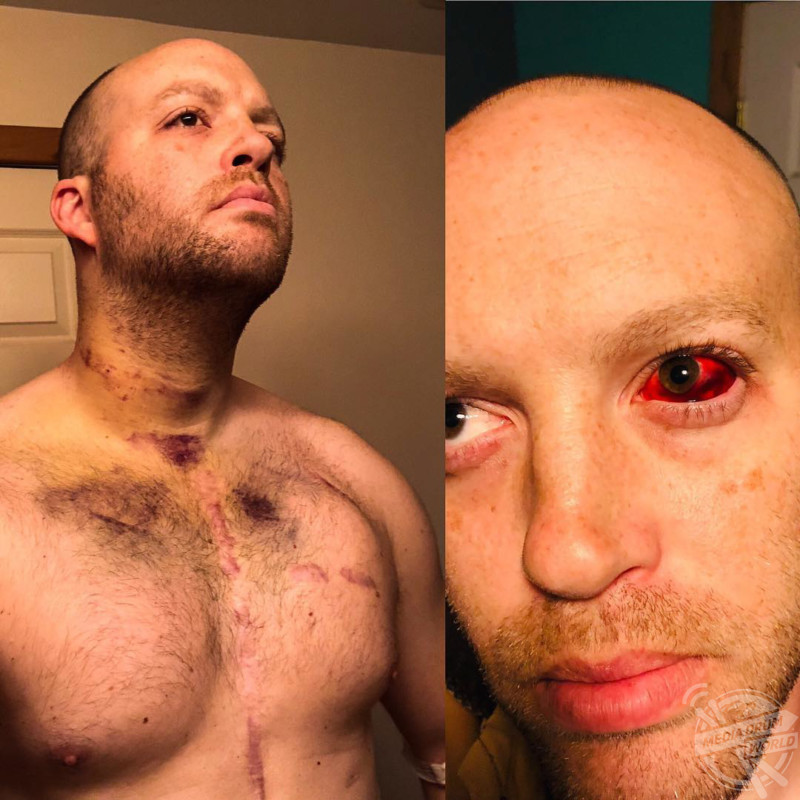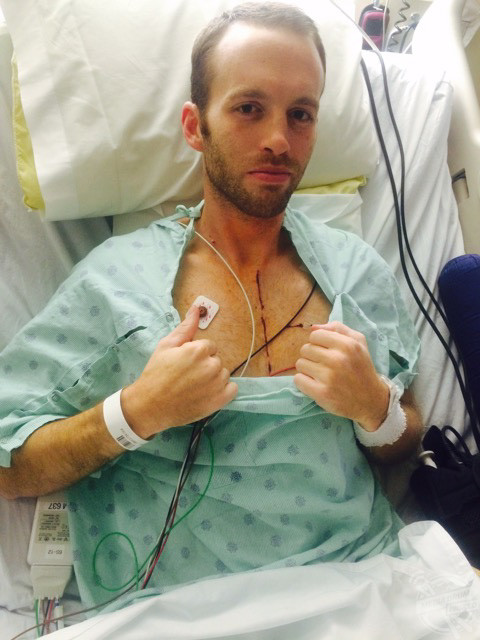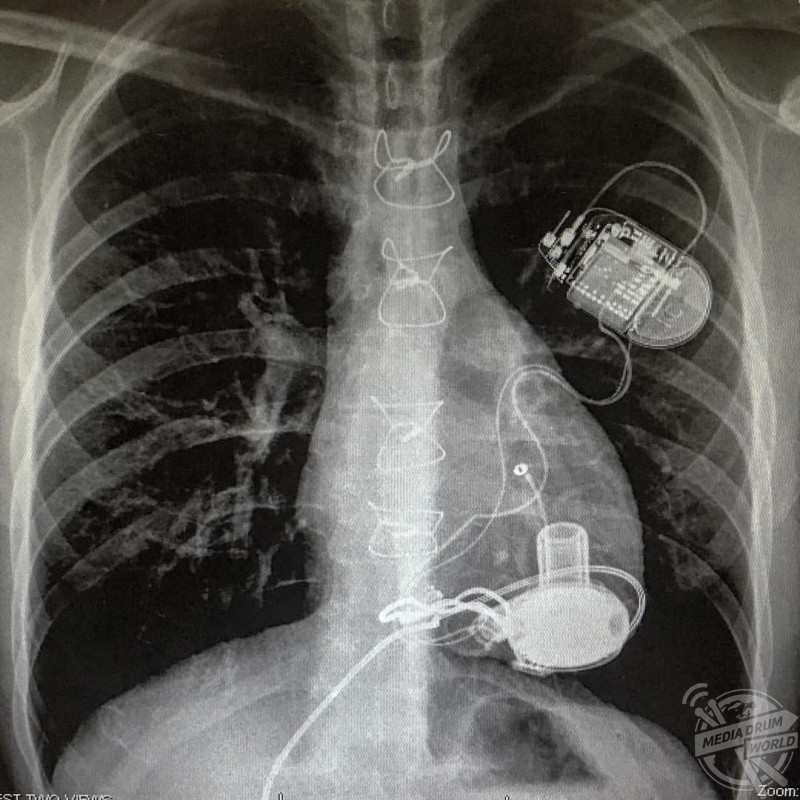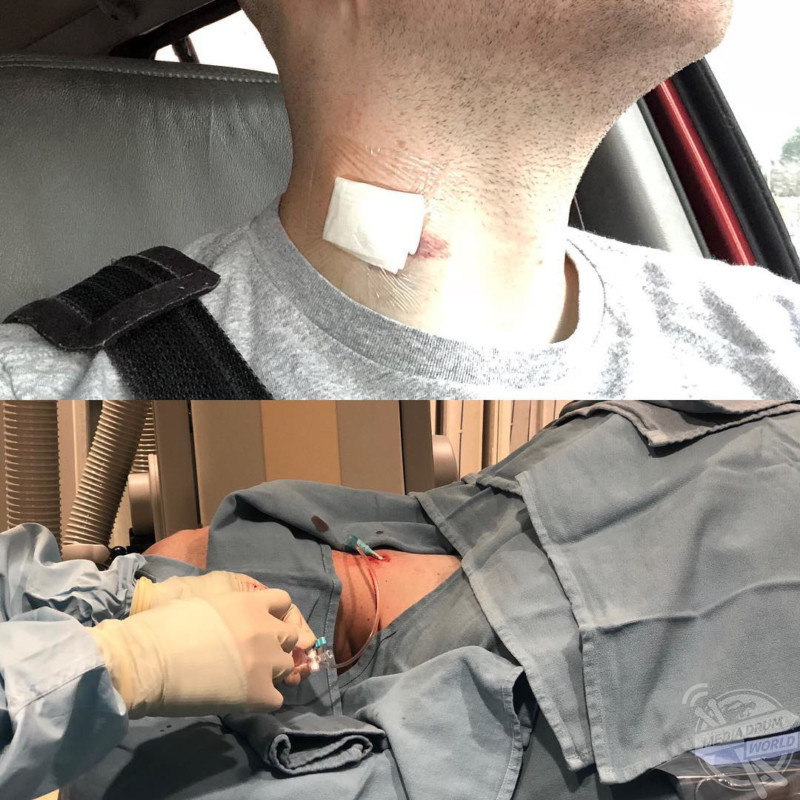By Alyce Collins
THIS ADVENTURE-LOVER has crested mountains and swam with sharks, but a routine knee surgery revealed he was suffering HEART FAILURE at the AGE OF THIRTY-TWO and now the only thing keeping him alive is a RECHARGEABLE mechanical heart.
Wilderness survival instructor, Jeremy White (35) from Washington, USA, has always loved adventure and travelling, having climbed America’s highest mountain peaks and leading scuba diving tours in Hawaii, until he battled a chest pain which was later discovered to be heart failure.

MDWfeatures / Jeremy White
During university, Jeremy went on as many study trips abroad as he could to fuel his love for travel, and he soon began taking work trips and even trying out winter survival courses.
In June 2015 Jeremy went into hospital for a minor knee surgery to rid him of his arthritis but shortly after waking up from surgery, Jeremy began experiencing chest pains and difficulty breathing.

MDWfeatures / Jeremy White
Doctors ran tests and examined Jeremy’s condition for three days before realising that he was in end stage heart failure, as his condition was declining continuously.
Doctors tried to keep Jeremy alive through medication and treatment, but these didn’t prevail and with no donor heart available, the only option was to implant a mechanical heart called a left ventricle assist device (LVAD) during a nine-hour surgery in July 2015.

MDWfeatures / Jeremy White
Jeremy’s LVAD has a battery life of 10 hours and plugs into the wall at night. This new change of pace has been incredibly difficult for Jeremy to accept as he admits he was even diagnosed with post-traumatic stress disorder (PTSD) after losing his previous lifestyle.
Jeremy is on the list for a heart transplant and he awaits a match, but until then he hopes to encourage others to remain determined to reach their goals, regardless of their condition.

MDWfeatures / Jeremy White
“Every chance I got to go on adventures I would, from studying abroad in Spain to winter survival courses and international business trips,” said Jeremy.
“My favourite adventure is hard to pick but scuba diving is one for sure. I also loved hiking, snowshoeing and airport roulette – it’s where to you go to an airport and you don’t know which flight you’re getting on until you board it.

MDWfeatures / Jeremy White
“During my first 30 years of life I was always very active, and I loved being outdoors, exploring and living life to the fullest.
“In my twenties I climbed some of the highest mountain peaks in the country, including Mount Rainier at 14,410 feet which is the highest point in my home state of Washington and Mount Whitney at 14,505 feet, the highest point in continental USA.

MDWfeatures / Jeremy White
“In June 2015 I had just returned from racing camels in Egypt and I was scheduled for a routine knee surgery. I had arthritis in my knee and doctors tried to fix it using part of a cadaver knee.
“Immediately after the surgery I began experiencing chest pains and struggled to breathe. As my symptoms continued, I was admitted to hospital and numerous tests were run. They ran tests to detect foreign viruses since I’d been travelling so much but nothing showed.

“The doctors were so perplexed by my symptoms as they couldn’t determine why a young, healthy guy was experiencing these problems.
“After enduring chest pain for three days, doctors finally determined that I had end stage heart failure and my heart function was drastically decreasing. The active and adventurous Jeremy was dying at 31 years old.

MDWfeatures / Jeremy White
“Doctors think that my heart condition had been going on for up to three months prior to the knee surgery. I was very fit and healthy, so my body was compensating for the weakness in my heart.
“Then I had the knee surgery which added physiological stress on my body and it was the tipping point for my heart condition to become symptomatic.

MDWfeatures / Jeremy White
“I stayed in the cardiac ICU for several weeks as doctors tried to keep me alive on various medication and treatment. The treatments helped but the pain never seemed to go away.
“For those who know me, they know I never give up, but this whole experience brought me to the end of my rope. Despite all my adventures, for the first time I was scared I may not make it out alive.

MDWfeatures / Jeremy White
“After a month my condition seemed to go from bad to worse, so the only option left was a heart transplant. At the time there were no donor hearts available, so doctors gave me a mechanical heart on July 19, 2015, which allows me to live until a heart is available.
“Implantation of an LVAD is one of the most difficult surgeries there is, and it took nine hours to do.

MDWfeatures / Jeremy White

MDWfeatures / Jeremy White
“The day after surgery I felt the immense pain and I felt like I’d been hit by a car when I woke up. As I lay in the hospital bed with incisions and tubes all over me, I began to think ‘is this worth it?’. I just wanted the pain to end.
“However, I didn’t give up and after a few days my condition began to improve. Then after 42 days in the hospital I was finally released to go home.”

MDWfeatures / Jeremy White
The last three years have seen Jeremy’s life change a considerable amount since the procedure, but he tries to remain positive and look ahead to the future.
“Compared to my previous lifestyle, life is drastically different now. I have gone through some tough periods of loss, even being diagnosed with a form of PTSD and life is much slower now than what it used to be,” said Jeremy.
“Instead of focusing on what I can’t do, I focus on what I can do. It’s hard because I once climbed mountains but now climbing a flight of stairs gets me out of breath.

MDWfeatures / Jeremy White
“The pump in my chest is powered by a battery pack which I carry round in a bag. The bag holds a controller and two batteries, and it has a wire going from that into my stomach which attaches to the pump. The battery lasts about 10 hours and at night I plug it into the wall.
“I have to take medication to thin my blood as required for an LVAD, so it can cause bruising and blood in my eyes. It’s usually nothing serious but it looks bad and I’m learning to deal with it.
“Getting a heart transplant has its own set of challenges but it will be far better than being on an LVAD. I will have to take certain precautions for the rest of my life, but I’ll be able to do many of the adventurous activities I used to do.

MDWfeatures / Jeremy White
“Bad things happen in the world and we can’t change that. However, we can change how we react and respond to them. It does no good to complain about the difficulties we face. What doesn’t kill you makes you stronger.
“When going through hard times it teaches you what you can make it through when you’re pushed to your limit. A huge part of not losing hope is to find something bigger than yourself to live for.”

MDWfeatures / Jeremy White
You can follow Jeremy’s journey by visiting @jeremysadventures.






